The Escalators And Moving Walkways Market is estimated to be valued at USD 19.5 billion in 2025 and is projected to reach USD 37.9 billion by 2035, registering a compound annual growth rate (CAGR) of 6.9% over the forecast period. Between 2025 and 2030, the market is expected to rise from USD 19.5 billion to USD 27.2 billion, driven by increasing urbanization, infrastructure development, and the need for efficient transportation systems in commercial and public spaces.
Year-on-year analysis shows consistent growth, with values reaching USD 20.8 billion in 2026 and USD 22.2 billion in 2027, supported by rising demand in airports, shopping malls, and transit hubs. By 2028, the market is forecasted to hit USD 23.8 billion, advancing to USD 25.4 billion in 2029 and USD 27.2 billion by 2030.
Innovations in energy-efficient systems, advanced safety features, and the integration of smart technologies for better monitoring and maintenance will further drive growth. These dynamics position escalators and moving walkways as essential components in modernizing infrastructure and improving accessibility, offering significant growth opportunities in the coming years across both developed and emerging markets.

| Metric | Value |
|---|---|
| Escalators And Moving Walkways Market Estimated Value in (2025 E) | USD 19.5 billion |
| Escalators And Moving Walkways Market Forecast Value in (2035 F) | USD 37.9 billion |
| Forecast CAGR (2025 to 2035) | 6.9% |
The escalators and moving walkways market is undergoing steady expansion driven by rapid urbanization, infrastructure modernization, and increasing demand for vertical mobility in public spaces. A notable increase in commercial complexes, metro rail projects, and airport terminals has created consistent procurement demand for both escalators and horizontal conveyance systems.
Technology integration, such as IoT-based diagnostics and energy-efficient drive systems, is improving operational reliability and long-term cost optimization. Government investments in smart city development and transit-oriented infrastructure are creating multi-phase rollout opportunities for manufacturers and service providers.
Moreover, retrofitting and replacement cycles in aging buildings are prompting demand for safer, high-performance mobility solutions. Looking ahead, innovations in space-efficient designs, noise reduction systems, and compliance with safety regulations are expected further to enhance market competitiveness and deployment across emerging economies.
The escalators and moving walkways market is segmented by product type, height, business, end use, and geographic regions. By product type, the escalators and moving walkways market is divided into Escalators, Parallel, Multi-parallel, Others (belt-type escalators, step type escalators, etc.), and Moving walkways. In terms of height of the escalators and moving walkways, the market is classified into Mid-rise, Low-rise, and High-rise.
The business of the escalators and moving walkways market is segmented into New equipment, Maintenance, and Modernization. The end use of the escalators and moving walkways market is segmented into Public transit, Airports, Retail, Institutional, and Others (corporate, government buildings, etc.).
Regionally, the escalators and moving walkways industry is classified into North America, Latin America, Western Europe, Eastern Europe, Balkan & Baltic Countries, Russia & Belarus, Central Asia, East Asia, South Asia & Pacific, and the Middle East & Africa.
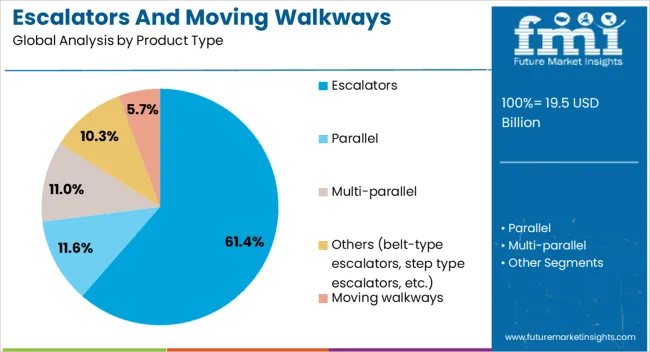
Escalators are projected to account for 61.40% of the total market revenue in 2025, establishing them as the dominant product type in the segment. The need for efficient vertical transport and crowd management has supported their widespread deployment in commercial buildings, metro stations, and airports.
Escalators provide high throughput, reliability under continuous operation, and enhanced safety through modern control and sensor technologies. Their adaptability to both indoor and outdoor installations, combined with low maintenance cycles due to modular component design, has strengthened their preference among infrastructure developers.
Increasing emphasis on space utilization and aesthetic integration in architectural planning has also contributed to their continued leadership within the product category.
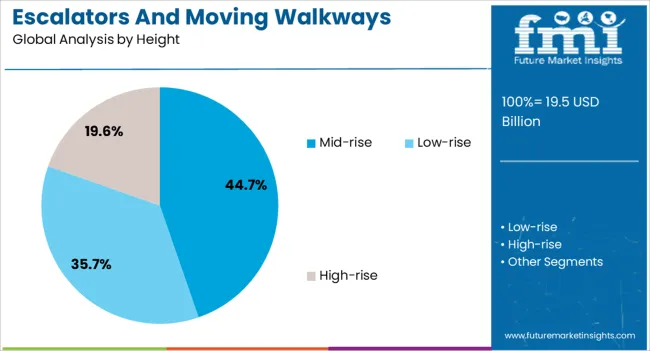
The mid-rise category is expected to contribute 44.70% of the overall market revenue by 2025, making it the leading height classification within the escalators and moving walkways market. This prominence is being driven by the boom in mid-rise residential and commercial buildings, particularly in urban and semi-urban centers of developing countries.
Mid-rise projects strike a balance between cost-efficiency and density optimization, making escalators and walkways ideal for supporting vertical circulation within limited footprints. The growth of tier-2 and tier-3 city developments, combined with incentives for vertical housing schemes, has further supported this segment’s relevance.
Equipment customized for mid-rise configurations also tends to have a shorter installation cycle and optimized power consumption, which appeals to developers managing project timelines and sustainability goals.
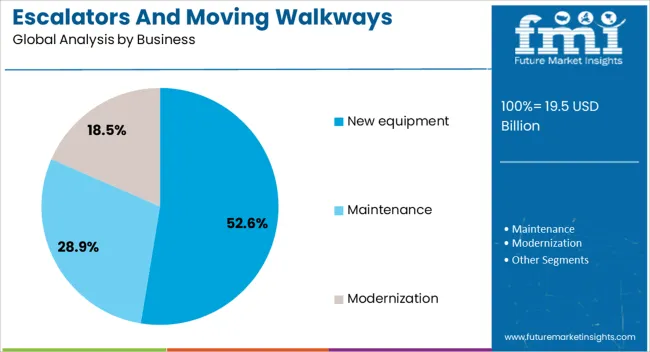
New equipment installations are forecast to generate 52.60% of the total revenue in the escalators and moving walkways market in 2025, placing them at the forefront of business segments. The global upsurge in new urban infrastructure, greenfield commercial projects, and public transit system expansions is fueling this growth.
The requirement for new systems that meet current energy efficiency, safety, and design standards has increased procurement in both public and private sectors. Additionally, major construction projects now incorporate vertical mobility at the planning stage, ensuring that escalator systems are not retrofitted but embedded as primary elements of building access.
Government initiatives in housing, airport upgrades, and transport infrastructure under national development programs are sustaining robust demand for new installations across regions.
The escalators and moving walkways market is growing due to increasing demand in commercial and transportation sectors. In 2024 and 2025, growth drivers include rising construction activities in urban infrastructure and the need for efficient passenger movement in airports and malls. Opportunities are emerging in the adoption of energy-efficient systems and smart escalators. Emerging trends include the integration of touchless technology and improved safety features. However, high installation costs and maintenance challenges in complex environments limit market expansion.
The primary growth driver for the escalators and moving walkways market is the expansion of urban infrastructure, especially in transportation hubs and commercial complexes. In 2024, urbanization and population growth led to increased demand for efficient vertical transportation in airports, shopping malls, and office buildings. Additionally, governments focused on improving infrastructure to meet public demand, further driving the need for escalators and moving walkways. These factors continue to push the market’s expansion in both developed and emerging markets.
Opportunities in the market exist with the rise of energy-efficient and smart escalator systems. In 2025, escalators with energy-saving features, such as variable speed control, gained popularity in high-traffic areas like airports. Additionally, the integration of smart systems, including sensors for predictive maintenance and touchless operation, opened new avenues for growth. These advancements not only reduce operational costs but also improve passenger experience, creating a compelling case for the adoption of energy-efficient, smart escalators and walkways in diverse sectors.
Emerging trends in the market include the increased focus on touchless technology and enhanced safety features. In 2024, touchless escalators, designed to minimize physical contact, gained traction in response to health concerns, particularly in high-traffic public spaces. Additionally, manufacturers focused on improving safety features, such as emergency braking systems and enhanced handrails, to meet stricter regulations. These trends indicate that safety and hygiene are becoming key considerations, prompting the development of more advanced and user-friendly systems in escalators and moving walkways.
Key restraints in the market include high installation costs and ongoing maintenance challenges. In 2024 and 2025, the high upfront investment for escalators and moving walkways in commercial and transportation settings remained a barrier for smaller developers and municipalities. Additionally, maintaining these systems in large or complex environments, such as airports and malls, required substantial ongoing investments in repairs and updates. These factors underscore the need for more affordable, low-maintenance solutions to foster wider adoption across diverse sectors.
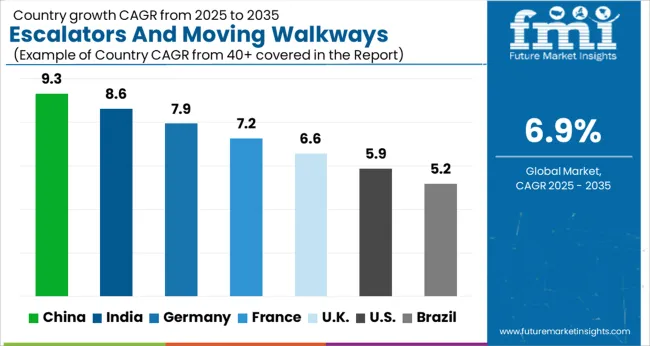
The global escalators and moving walkways market is projected to grow at 6.9% CAGR from 2025 to 2035. China leads with 9% CAGR, driven by rapid urbanization, growing infrastructure projects, and increasing demand for mobility solutions in public transportation and commercial buildings. India follows at 9%, supported by urban development, expanding retail sectors, and increased need for high-capacity mobility solutions in shopping malls, airports, and train stations.
Germany records 8% CAGR, reflecting strong demand from the transportation sector, including metro stations, airports, and commercial spaces. The United Kingdom grows at 7%, while the United States posts 6%, reflecting steady demand in mature markets with a focus on accessibility, energy efficiency, and integration with smart building systems. Asia-Pacific leads growth, with Europe and North America focusing on high-performance solutions and sustainability.
The escalators and moving walkways market in China is forecasted to grow at 9% CAGR, driven by rapid urbanization, large-scale infrastructure projects, and an increasing focus on smart transportation solutions in metro systems, shopping malls, and airports. China’s growing real estate sector and ongoing urban development projects create strong demand for advanced escalator and moving walkway systems. Additionally, the country’s push for sustainable and energy-efficient mobility solutions further accelerates market growth.
The escalators and moving walkways market in India is projected to grow at 9% CAGR, driven by the country’s expanding retail, commercial, and transportation sectors. The increasing number of shopping malls, airports, and metro stations across the country creates significant demand for efficient and high-capacity mobility solutions. Additionally, India’s focus on infrastructure development, combined with government initiatives to enhance public transport and accessibility, accelerates market growth.
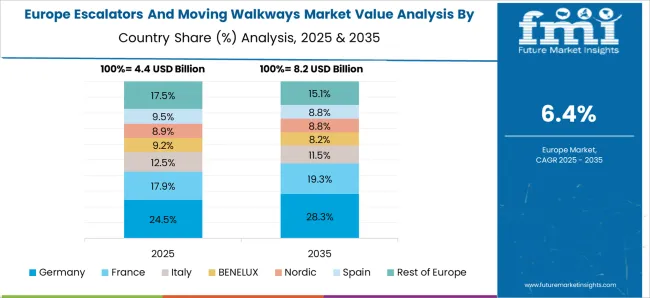
The escalators and moving walkways market in Germany is expected to grow at 8% CAGR, driven by increasing demand from metro stations, airports, and commercial buildings. As Germany continues to invest in transportation and public infrastructure, there is growing demand for mobility solutions that enhance accessibility and transport efficiency. Furthermore, the country’s focus on energy-efficient and sustainable building solutions strengthens the adoption of eco-friendly escalators and moving walkways in public spaces.
The escalators and moving walkways market in the United Kingdom is projected to grow at 7% CAGR, supported by rising demand for energy-efficient mobility solutions in commercial and public spaces. The UK’s commitment to sustainable building practices and accessibility standards drives the demand for smart escalators and moving walkways in airports, shopping malls, and public transportation systems. The integration of escalators and moving walkways with smart building systems, such as sensors for maintenance and energy management, further fuels market growth.
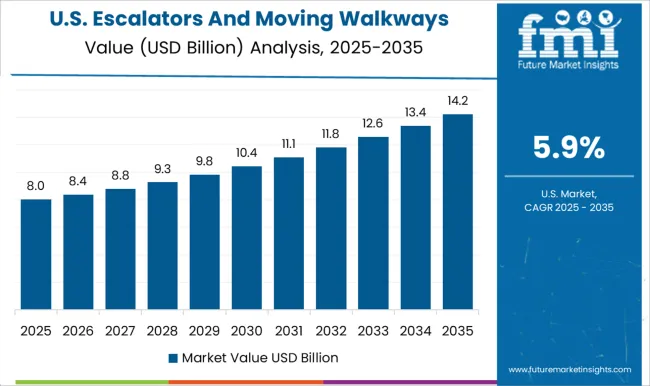
The escalators and moving walkways market in the United States is projected to grow at 6% CAGR, reflecting steady demand in a mature market with a focus on advanced features and sustainability. The growing emphasis on smart city development and transportation solutions in airports, shopping malls, and transportation hubs fuels the adoption of high-performance escalators and moving walkways. Additionally, the demand for energy-efficient and low-maintenance systems increases in both commercial and residential buildings, contributing to market growth.
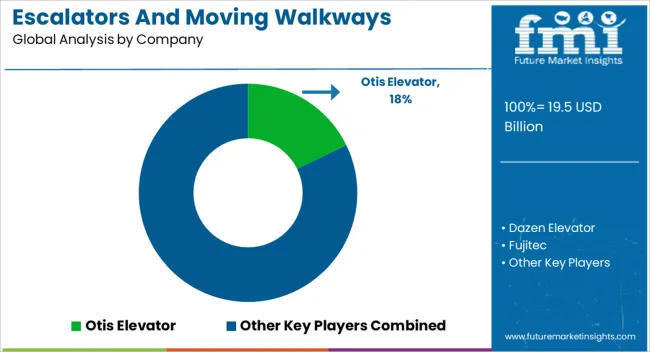
The escalators and moving walkways market is dominated by Otis Elevator, which secures its leadership through a comprehensive range of vertical transportation solutions for both commercial and residential applications. Otis strengthens its dominance with advanced technology, energy-efficient designs, and a strong global service network.
Key players such as KONE, Schindler, Mitsubishi Electric, Fujitec, and TK Elevator maintain significant market shares by offering high-performance escalators and moving walkways designed for improved safety, energy efficiency, and smooth operation in high-traffic areas like malls, airports, and transit stations. These companies focus on innovation in digital connectivity, remote monitoring systems, and eco-friendly solutions to meet increasing demand for sustainable infrastructure.
Emerging players including Dazen Elevator, Hyundai Elevator, Johnson Lifts, KLEEMANN, Sigma Elevator, Sicher Elevator, Stannah, and Toshiba are strengthening their market presence by providing cost-effective, customizable solutions, and targeting regional market demands. Their strategies focus on improving system reliability, reducing installation costs, and incorporating modern design elements for aesthetic appeal.
Market growth is driven by rising urbanization, the increasing demand for smart and energy-efficient transportation systems, and ongoing infrastructure development in emerging markets. Technological advancements in predictive maintenance, smart sensors, and advanced material use will continue to shape competitive dynamics in the global escalators and moving walkways market.
Manufacturers are increasingly focusing on energy-efficient escalators and moving walkways. The development of regenerative drives and LED lighting systems is reducing energy consumption, making these systems more environmentally friendly and cost-effective. These systems convert the energy produced by the movement into usable power, improving energy savings and lowering operational costs for users.
| Item | Value |
|---|---|
| Quantitative Units | USD 19.5 Billion |
| Product Type | Escalators, Parallel, Multi-parallel, Others (belt-type escalators, step type escalators, etc.), and Moving walkways |
| Height | Mid-rise, Low-rise, and High-rise |
| Business | New equipment, Maintenance, and Modernization |
| End use | Public transit, Airports, Retail, Institutional, and Others (corporate, government buildings, etc.) |
| Regions Covered | North America, Europe, Asia-Pacific, Latin America, Middle East & Africa |
| Country Covered | United States, Canada, Germany, France, United Kingdom, China, Japan, India, Brazil, South Africa |
| Key Companies Profiled | Otis Elevator, Dazen Elevator, Fujitec, Hitachi, Hyundai Elevator, Johnson Lifts, KLEEMANN, KONE, Mitsubishi Electric, Schindler, Sicher Elevator, Sigma Elevator, Stannah, TK Elevator, and Toshiba |
| Additional Attributes | Dollar sales by system type and application, demand dynamics across commercial, residential, and transportation sectors, regional trends in escalator and moving walkway installations, innovation in energy-efficient and smart systems, impact of regulatory standards on safety and accessibility, and emerging use cases in smart cities and public transportation hubs. |
The global escalators and moving walkways market is estimated to be valued at USD 19.5 billion in 2025.
The market size for the escalators and moving walkways market is projected to reach USD 37.9 billion by 2035.
The escalators and moving walkways market is expected to grow at a 6.9% CAGR between 2025 and 2035.
The key product types in escalators and moving walkways market are escalators, parallel, multi-parallel, others (belt-type escalators, step type escalators, etc.) and moving walkways.
In terms of height, mid-rise segment to command 44.7% share in the escalators and moving walkways market in 2025.






Our Research Products

The "Full Research Suite" delivers actionable market intel, deep dives on markets or technologies, so clients act faster, cut risk, and unlock growth.

The Leaderboard benchmarks and ranks top vendors, classifying them as Established Leaders, Leading Challengers, or Disruptors & Challengers.

Locates where complements amplify value and substitutes erode it, forecasting net impact by horizon

We deliver granular, decision-grade intel: market sizing, 5-year forecasts, pricing, adoption, usage, revenue, and operational KPIs—plus competitor tracking, regulation, and value chains—across 60 countries broadly.

Spot the shifts before they hit your P&L. We track inflection points, adoption curves, pricing moves, and ecosystem plays to show where demand is heading, why it is changing, and what to do next across high-growth markets and disruptive tech

Real-time reads of user behavior. We track shifting priorities, perceptions of today’s and next-gen services, and provider experience, then pace how fast tech moves from trial to adoption, blending buyer, consumer, and channel inputs with social signals (#WhySwitch, #UX).

Partner with our analyst team to build a custom report designed around your business priorities. From analysing market trends to assessing competitors or crafting bespoke datasets, we tailor insights to your needs.
Supplier Intelligence
Discovery & Profiling
Capacity & Footprint
Performance & Risk
Compliance & Governance
Commercial Readiness
Who Supplies Whom
Scorecards & Shortlists
Playbooks & Docs
Category Intelligence
Definition & Scope
Demand & Use Cases
Cost Drivers
Market Structure
Supply Chain Map
Trade & Policy
Operating Norms
Deliverables
Buyer Intelligence
Account Basics
Spend & Scope
Procurement Model
Vendor Requirements
Terms & Policies
Entry Strategy
Pain Points & Triggers
Outputs
Pricing Analysis
Benchmarks
Trends
Should-Cost
Indexation
Landed Cost
Commercial Terms
Deliverables
Brand Analysis
Positioning & Value Prop
Share & Presence
Customer Evidence
Go-to-Market
Digital & Reputation
Compliance & Trust
KPIs & Gaps
Outputs
Full Research Suite comprises of:
Market outlook & trends analysis
Interviews & case studies
Strategic recommendations
Vendor profiles & capabilities analysis
5-year forecasts
8 regions and 60+ country-level data splits
Market segment data splits
12 months of continuous data updates
DELIVERED AS:
PDF EXCEL ONLINE
Airport Moving Walkways Market Size and Share Forecast Outlook 2025 to 2035
Elevators and Escalators Market Analysis - Size, Share, and Forecast Outlook 2025 to 2035
Android Automotive OS (AAOS) Market Size and Share Forecast Outlook 2025 to 2035
Anderson Cascade Impactor Market Size and Share Forecast Outlook 2025 to 2035
Moving Supplies Market Analysis - Growth & Demand 2025 to 2035
Andersen-Tawil Syndrome Treatment Market Trends - Growth & Future Prospects 2025 to 2035
Andro Supplements Market
Candle Filter Cartridges Market Size and Share Forecast Outlook 2025 to 2035
Handheld Electrostatic Meter Market Size and Share Forecast Outlook 2025 to 2035
Hand Towel Automatic Folding Machine Market Size and Share Forecast Outlook 2025 to 2035
Handheld Ultrasound Scanner Market Size and Share Forecast Outlook 2025 to 2035
Handheld Tagging Gun Market Forecast and Outlook 2025 to 2035
Handheld Imaging Systems Market Size and Share Forecast Outlook 2025 to 2035
Sandwich Panel System Market Size and Share Forecast Outlook 2025 to 2035
Hand Tools Market Size and Share Forecast Outlook 2025 to 2035
Land Survey Equipment Market Size and Share Forecast Outlook 2025 to 2035
Handloom Product Market Size and Share Forecast Outlook 2025 to 2035
Band File Sander Belts Market Size and Share Forecast Outlook 2025 to 2035
Handheld XRF Analyzers Market Size and Share Forecast Outlook 2025 to 2035
Sand Abrasion Tester Market Size and Share Forecast Outlook 2025 to 2035

Thank you!
You will receive an email from our Business Development Manager. Please be sure to check your SPAM/JUNK folder too.
Chat With
MaRIA